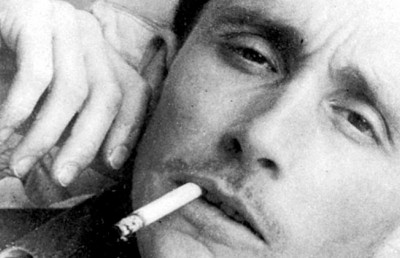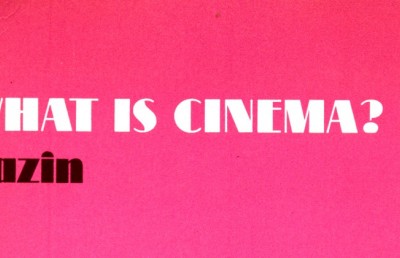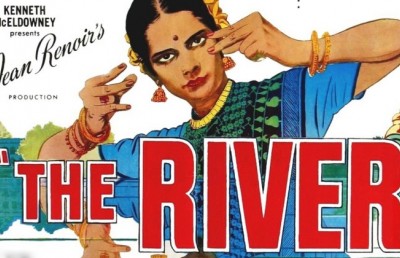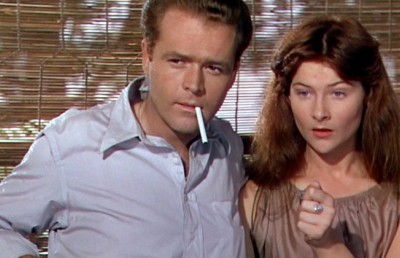Introduction to André Bazin, Part 2: Style as a Philosophical Idea
André Bazin Revisited
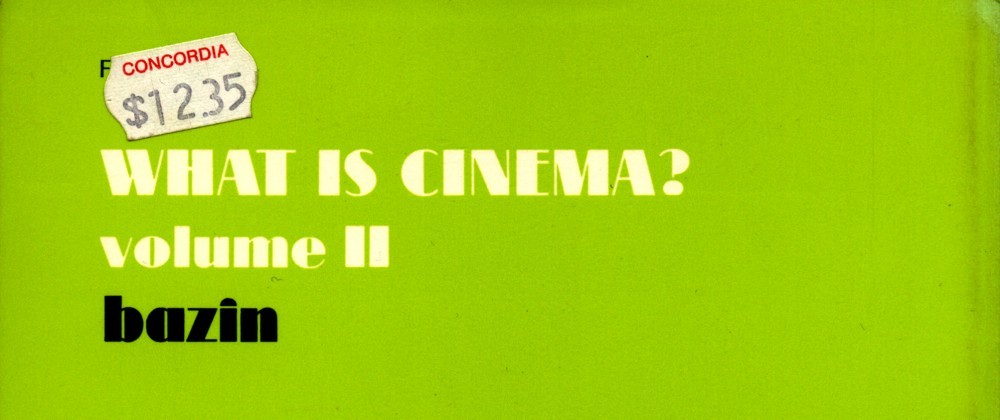
AN INTELLECTUAL-BIOGRAPHICAL INTERLUDE
Bazin’s theoretical conjectures, mystical and impenetrable for many, become clearer when placed in the context of Bazin’s background. Bazin, born in 1918, lived through one of the most fertile and probing intellectual movements of the past half century. France during the 30’, 40’s, and 50’s saw rise to several great thinkers and philosophical movements. The three which made the deepest impression on Bazin were Jean-Paul Sartre (Existentialism), Maurice Merleau-Ponty (Phenomenology), and Emmanuel Mounier (Personalism), whose impact on Bazin will be dealt with in my concluding comments. Although these three thinkers sometimes clashed, they had common concerns – the condition of modern (wo)man- and their works often overlapped. Sartre and Merleau-Ponty co-edited the journal Les Temps Modernes (to which Bazin often contributed) and Mounier founded the journal L’Esprit (Esprit), for which Bazin wrote some of his best film criticism. A fourth influence on Bazin was Roger Leenhardt, one of the earliest realist film critics and the Espirit‘s original film critic. Once Bazin reared his critical skills Leenhardt, realizing Bazin’s talents, stepped down as film critic and opened up the position for Bazin (Roud 177). This interweaving and reciprocation of thoughts and ideas helped form Bazin the human being and Bazin the film theorist.
Bazin’s writing begins to crystalize when seen under the light of phenomenology. According to Merleau-Ponty, the heir to its founder Edmund Husserl, phenomenology is the study of essences. Adopting Husserl’s tenet of returning “to the things themselves” Merleau-Ponty searched for a new form of knowledge to describe phenomena. The return Husserl spoke of was a return to “a careful description of things as they appear and of the consciousness in which they appear….” This “careful description” preserved the richness and complexity inherent in every phenomena, which eluded previous philosophies (Bannan 3).
How does phenomenology reveal itself in Bazin’s writings? The most lucid insights into this bridge are given by Dudley Andrew, one of the only contemporary theorists concerned with the increasing gulf between phenomenology and film theory.
Vital to Bazin’s film theory is his conception of reality. In reference to this, Andrew describes the phenomenological notion of reality accepted by Bazin:
…Bazin would be obliged to say that the real exists only as perceived, that situations can be said to exist only when a consciousness is engaged with something other than itself. In this view reality is not a completed sphere the mind encounters, but an “emerging- something” which the mind essentially participates in. Here the notion of ambiguity…is more than a result of human limitation. Here ambiguity is a central attribute of the real. For Marcel and Merleau-Ponty, there can be no complete knowledge of a situation, but instead a more and more sensitive response to the mysterious otherness which consciousness engages. Thus ambiguity becomes a value, a measure of the depths of the real (Film Comment 64).
To Bazin the “mysterious otherness” is reality vis- a- vis the film image and the “more sensitive response” his mise- en- scéne style. Therefore the presence of ambiguity, frequently mentioned by Bazin, fortifies the essential and inherent complexity of reality and perception.
Another important insight into Bazin from the above quote is the passage where reality is described as an “emerging-something”, which relates clearly to Bazin’s belief in a film style which allows for the greatest spectator participation in meaning. This can be also used to defend Bazin against ideological critics who read Bazin’s view of reality as somehow untouched by social and political conditions. The notion of an “incomplete” reality allows for a multiplicity of meaning which can encompass the social, political, and philosophical. Bazin’s ideal of an art that approaches ‘true realism’ is not an art that overlooks ideological meaning, or denies its existence, but that attempts to work through it. The idea of a filmmaker who is able to achieve ‘true realism’ does not mean that they are somehow outside or beyond ideology. Merely that they are aware of it and present a personal vision which aims to counter, step beyond, or remain as unaffected as possible by that ideology. It would be just as ludicrous and wrongheaded to say that a filmmaker is ‘trapped’ by/into ideology and therefore completely helpless to do anything to counter or fight against that ideology (barring some extreme exceptions). In Younger’s defense of Bazin, this is explained as an artist who achieves “the possibility of unalienated experience.”
Hence, far from being unaware of the force of ideology, Bazin believes that art, through the power of (art)ifice, and perhaps because of it, has the potential to move beyond “pseudoreality.” One of Bazin’s most often quoted (and maligned) passages is a poetic manifestation of this creative energy:
The aesthetic qualities of photography are to be sought in its power to lay bare the realities. It is not for me to separate off, in the complex fabric of the objective world, here a reflection on a damp sidewalk, there the gesture of child. Only the impassive lens, stripping its object of all those ways of seeing it, those piled-up preconceptions, that spiritual dust and grime with which my eyes have covered it, is able to present it in all its virginal purity to my attention and consequently to my love. By the power of photography, the natural image of a world that we neither know nor can see, nature at last does more than imitate art: she imitates the artist. 1
In this passage Bazin echoes another likely influence on his thought, a philosopher whose ideas were clearly “in the air” during Bazin’s formative years, Henri Bergson. Bergson, who died in 1941, was a unique thinker who did not fit into any particular philosophical school, but whose popularity was instrumental in nurturing many of the intellectual trends in early 20th century France which would eventually coelesce into Existentialism and Phenomenology. The “true realism” which Bazin looked for in film can be likened to Bergson’s ‘durée’ (duration), expressed as real time in opposition to spatialized time. For Bergson, as Bazin, it was the artist who was best equipped to see through the ‘veil’ of ‘pseudoreality’ (which can be ideology, illusionism, overwrought formalism, etc.). It is in the third chapter of his long essay on comedy, Laughter, that Bergson discusses the relationship between art and reality in a manner which suggests Bazin. The necessities of living (work, social conformity, bodily functions) force a barrier in between both ourselves and the flux of reality and our superficial and fundamental self. This barrier is “dense and opaque for the common herd – thin, almost transparent for the artist and the poet” (Bergson, 158). The common person is bound to a pragmatic communicational system that includes language, symbols, concepts and abstractions (spatialized time). These are necessary but, in Bergson’s system, can not approach duration. The artist is less bound to this utilitarian system, which places the artist in a better position to experience duration because of the artist’s natural inclination to disengage from the pragmatic and utilitarian demands of social conduct. Compare, then, the following Bergson quote to the above passage from Bazin:
So art, whether it be painting or sculpture, poetry or music, has no other object than to brush aside the utilitarian symbols, the conventional and socially accepted generalities, in short, everything that veils reality from us, in order to bring us face to face with reality itself (162).
Another interesting parallel that exists between Bergson and Bazin is the affinity between Bergson’s distrust of ‘spatialized time’ and Bazin’s distrust of montage. In the section on Montage in part 1 I concluded that, for Bazin, the integrity of spatial unity is of the utmost importance and supercedes all other considerations. This moral imperative to maintain temporal and spatial wholeness has a philosophical parallel to Bergson. In Bergson’s philosophy spatialized time, a by-product of the intellect’s propensity to analyze and fragment, stands in opposition to the indivisible and ongoing durée, or real time (duration). Although spatialized time is a necessary part of knowledge, it can often be hindered by the pragmatic necessities of everyday. Duration, on the other hand, is something which we grasp in moments of complete freedom, self-awareness, and authenticity (for example, through intuition rather than the intellect). I would suggest that Bazin’s ‘moral/ethical’ preference for mise-en-scéne over montage was, in part, influenced by Bergson’s own preference for duration (filmic spatial/temporal unity) over spatialized time (montage).
I will now return to and conclude the discussion of Bazin and phenomenology. To further clarify the connection between Bazin and phenomenology I quote Andrew for a second time. Referring to the difference between the structuralists and the phenomenologists Andrew writes:
The former (structuralists), proceeding out of a higher logic, can envision a utopia of signs, of knowledge, and of communication, a cinema which will beclear, just, and demystified. The latter (phenomenologists) are anxious to change nothing but instead to comprehend a process which flows along perfectly well on its own. Indeed, phenomenologists have a longstanding distrust of pure reason, viewing rationality as a single mode of consciousness among others, a mode whose unquenchable thirst to swallow all experience must be restrained precisely because life itself tells us that experience is dearer and more trustworthy than schemes by which we seek to know and change it (Movies and Methods Vol.2 631).
It becomes clear that as phenomenologists distrust strict logicians and reductionists, Bazin distrusts the formalists, or more accurately, filmmakers who rely on the illusionistic powers of cinema to misrepresent reality. The film grammarians, claims Andrew, force us to leave cinema and focus on a second-level system (a logical sign system for the semiologists). Phenomenology focuses on the pure experience of an event, hence the phenomena of the film experience itself becomes the only touchstone needed to begin to understand film and the relationship between it and the spectator. By eliminating the second level system we remain closer to the phenomena and also eliminate whatever inconsistencies may be open to the structural or semiotic method (or any other method which distances you from the film event.) The peculiarity of the film experience – with its unique discourse strategies, emotionalism, affinity to the individual and collective unconscious- makes it complex autonomously and, possibly, does not beg to be totally demystified or fragmented like a cryptogram.
Throughout Bazin’s writings he speaks of film as if it were not the reproduction of an event but the (or a) event itself. This “primacy” felt for the film experience has an explicit affinity with Merleau-Ponty. In the Primacy of Perception Merleau-Ponty says: “ by the words, the “primacy of perception,” we mean that the experience of perception is our presence at the moment when things, truths, values are constituted for us.” (25) This could apply to the primacy of a photograph or film taken years earlier. Although the person watching a film today is aware of its “pastness” it only becomes an actual experience for the viewer ‘now’ because of this primacy of perception.
Merleau-Ponty also wrote an essay on film in 1947 entitled “The Film and the New Psychology” (48- 59). Merleau-Ponty sees film as a Gestalt mosaic and goes on at great length about the Pavlov experiments, the Kuleshov experiment, and their relationship to film editing – not exactly concepts which would seem to have inspired Bazin. Although Merleau-Ponty and Leenhardt, like Eisenstein and Pudovkin, place high value on editing as both a structural and expressive device, they also see cinema as the most realistic of arts. Of film Merleau-Ponty says that it is “the closest possible reproduction of a drama” and that “the actors should be natural, the set should be as realistic as possible.” He strengthens his case by quoting Leenhardt: “The power of reality released on screen is such that the least stylization will cause it to go flat.” There is one particular comment by Merleau-Ponty which foreshadows one of Bazin’s most important aesthetic and moral credos – the presentation of spatial unity/integrity: “The joy of art lies in its showing how something takes on meaning – not by referring to already established and acquired ideas but by the temporal or spatial arrangements of elements” (58- 59). As evidenced through these statements, the link between Merleau-Ponty and Bazin is, assuredly, significant.
The existentialist Jean-Paul Sartre wrote periodically on the arts, especially theatre and literature, but reserved a special place in his heart for the cinema. In 1931, at the age of 26, Sartre wrote a laudatory essay on cinema entitled “L’art cinématographique.” (546- 552) At the time Bazin was but thirteen years of age. It’s pure speculation, but the reverential tone of the essay, as well as many of its insights, may very well have lit the fire under Bazin. Much of what Sartre says seems to echo throughout Bazin’s writings. Sartre praises the cinema for its innocence, its humanistic potential, its immediacy, and, above all, its mimetic qualities (my translation): “At the same time it (cinema) is, of all the arts, the closest to real life: real men living in real countrysides. The Montagne sacrée is a real mountain, the mother in Finis Terrae is a real mother. All appears natural, except the walk towards the end which we can not stop.” (549)
Sartre speaks of the “irreversibility of time” and how life, forever grounded in it, is caught in this fatalistic forge toward the end. Although this time consumes us, we do not perceive it minutely, that is each moment giving away to the next. That would be unbearable. Rather, we experience time evolving spontaneously, by chance; people age, people die, and events happen to and around us. The arts of movement (theatre, music, film) reproduce this irreversible time for us but “outside us.” The cinema, although also fatalistic, is different because it does not occupy the same “abstract and cut” time as theatre. Cinema, in its frankness, realism, and immediacy best exemplifies the “inhuman necessity” of irreversible time and man’s forced relation to it.
Cinema achieves this quality through its ability to juxtapose themes in time and space. The terms Sartre uses to coin this ability are “surimpression” (superimposition) and “polyphonies cinématographique” (cinematographic polyphony). This simultaneity of themes can be expressed in two ways: through editing (Bazin’s “imagists”), as he demonstrates with an example from Abel Glance’s Napoleon, or with what Sartre believes to be a more elegant manner, by the joining of two themes within the same scene/shot (Bazin’s “realists”). To describe the “more elegant” manner Sartre uses an example from Pabst’s Joyless Street. The scene contrasts the poverty and shattered moral of the post-war populace with the dishonest wealth and happiness of the wartime profiteer. A group of miserable, downtrodden people are lined up outside a butcher shop; a profiteer, driving to his local tavern via his fancy car, grazes the crowd and, with the sweep of his headlights, exposes the despairing faces within the crowd. He disappears after this fleeting moment. What Sartre admires most about this scene is its seemingly inconsequential nature. This “more elegant” manner Sartre refers to would find its double in Bazin’s unified and homogenous space.
Bazin’s philosophical heritage deeply influenced the development of his personality and ideals. Out of Mounier’s Personalism evolved Bazin’s Catholic humanism; out of Merleau-Ponty’s phenomenology evolved Bazin’s notion of reality, ambiguity, and the perceptual immediacy of the film experience; and through Sartre, Bazin realized the importance and potential of cinema as a realistic art, while also opening up to existentialism. The tone of his writings, sometimes clear, sometimes ambiguous or allegorical, and always invigorating, reflect this intellectual development.
BAZIN RESCUED FROM HIS CRITICS
In this final section I would like to address some of the criticism that has been leveled at Bazin since the turn to politicized film theory models. This section will serve as an introduction of sorts to the essays by Prakash Younger, which address the issue of Bazin’s legacy by demonstrating how much of this criticism is based on misreadings or incomplete readings of Bazin. Younger addresses these complex issues with the rigor and intelligence they deserve, and argues convincingly for the continued relevancy of Bazin in film studies today. At the heart of most anti-Bazinian writing is the idea that Bazin was a mystical-minded thinker who did not understand or acknowledge the ideological underpinnings of film. According to these ideological critics Bazin used a series of metaphysically tinged arguments to promote a particular film style (use of the long take, depth of field, moving camera, naturalistic acting, etc.) that depicted a wholistic and hence more realistic representation of the world than montage-based or overly expressionistic styles. Other contested issues, as seen through the eyes of the ideological critics, were Bazin’s equation of cinema’s mechanical agency with objectivity; the seeming contradictions between his theory and criticism (i.e. championing directors not known for their realism); the reductive nature of his notion of a ‘transcendent’ reality that can never be fully understood (“existential ambiguity”); and the prescriptive and therefore creatively reductive nature of his preferred realist film style. For a detailed rebuttal to these criticisms I direct you to the three essays by Younger. I will limit myself to a prosaic defense of this image of Bazin as a politically naïve ‘mystic’.
Many “enlightened” contemporary critics and theorists simply write Bazin off as a naïve realist who omitted the ideological underpinnings of the image. From this they extrapolate an “idealistic” theory that points to a spiritual or ambiguous reality that overlooks social and political reality. The model to begin the counter-argument against this erroneous impression of Bazin is Emmanuel Mounier. Mounier, a Christian humanist, played a large role in shaping Bazin’s vision of the world (Gray, int. What is Cinema Vol.2 3, Andrew, 29-37). Mounier saw the world around him encroaching on and suffocating humanity. Stifled by Individualism (Bourgeois & Capitalism) and Collectivism (Fascism, Socialism, Communism), Mounier envisioned an eventual apocalypse (a “tragic optimism”) and then a utopia based on the concepts of the person and the community: freedom, the family, spiritual and moral rebirth (Amato 129- 147). Mounier eventually rebelled against his academic post and made the journal he founded, Esprit, an organ of politically motivated cultural criticism. Mounier took repeated stances against all forms of Fascism (German, Italian, Spanish), criticised Christianity for not engaging in social action, condemned the French bombing of Indo-China in 1935, and eventually joined the Resistance and was imprisoned by the Vichy government. In the introduction to Mounier’s book Personalism, Rufus William Rauch Jr. expresses the type of ‘engaged’ spiritualism which characterised Mounier’s Personalism and reflects Bazin’s own brand of ‘spiritual,’ but categorically not apolitical, film criticism:
…Mounier addressed himself to the complex relationship of the spiritual in the temporal without compromising the former in any kind of clericalism or mysticizing the latter by evading the concrete problems of the human condition…. He believed that although man’s goal is beyond the temporal and beyond human history, man must, with all of his frailties, seek this goal within the changing materials of history (x).
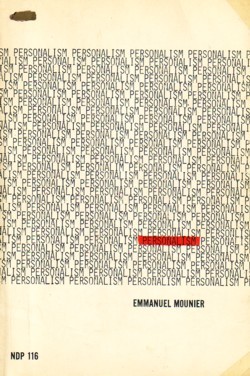
I also find it more than just a little ironic that much of this criticism against Bazin comes from the relatively safe haven of academia, whereas Bazin, after his mentor Mounier, lived what he preached. Bazin was an ambassador of film, travelling around among his community presenting films and discussing them at film-clubs, workers groups, and church halls. He was not politically naïve, nor was he unconcerned with real human problems. He may have been an idealist, but if so, because he believed in humanity. This does not mean he was politically naïve; far from it. Ideologically he was a liberal humanist who was an instrumental figure of several left-wing journals, including the Catholic-left journal Espirit, Travail et Culture and the journal he founded, Cahiers du Cinema. Anyone who refers to Bazin as ‘apolitical’ has not read enough of his work. Outside of the obvious left-leaning political nature of his book on the cinema of the French Resistance (French Cinema of the Occupation and Resistance), is his remarkable and prescient critique of Stalinist Socialist Realism, “The Stalin Myth in Soviet Cinema.”
With this essay Bazin was, as usual, an astute observer ahead of his time by denouncing socialist realist films for their mythologizing of Stalinism (mixing of myth, history and propaganda). At the forefront of Bazin’s attack on these films was the perverse and near-fetishistic idolatry of Stalin. As Bazin sensibly noted, a person can not place themselves in history while history is still being made! As Andrew notes in his introduction to the essay, Bazin showed great integrity by writing this staunch critique of Stalinist propaganda at a time, 1950, when many French socialists were still supportive of Stalin. After the article came out to press Andrew notes that Bazin “…had to duck in and out of the Esprit office for fear of running into a verbal or physical battle.” (Andrew, Introduction to “The Stalin Myth in Soviet Cinema.” 1985, 30.).
In fact Nikita Khrushchev, in his famous 1956 speech where he denounced Stalin, made mention of the role of cinema in the fabrication of historical lies and the distorted view of Russia. Bazin felt so vindicated that he wrote an appendix in 1958, a few months before his death, where he brought this fact out for all his naysayers to see (Bazin even implies that Khrushchev might have read his piece). 2
The image of Bazin that emerges from Dudley Andrew’s wonderful critical biography André Bazin is of a devoted but divided soul. Bazin played an active role in the artist’s and intellectual’s part of the Resistance in France but never sacrificed art for politics. He was implicitly religious, but felt guilty for not dedicating himself or even giving religion a priority in his life. He lived an active life dedicated to elevating the art of film, but always within the context of society and reality. He saw film as the art best suited to serving the glory of reality. Bazin fought to preserve a sense of, as he called it, “existential ambiguity” that exists in all of life. He believed, as did the phenomenologists, that reality is so rich in its complexity and/or ambiguity that to dissect, fragment, or worst of all, try to artistically improve upon reality is a form of sacrilege. However, too many critics erroneously latch on to this notion of “existential ambiguity” as if it categorically denies a real world with real problems. The ideological critics reduce Bazin by assigning only a religious or metaphysical meaning to the reality Bazin describes. On the contrary, the way Bazin led his life gives sure indication that social, political and ideological constructs were an undeniable part of what made reality so “rich and complex” for Bazin.
In whatever sense film appropriates reality, for Bazin it remains always as an “artifice” which is dependent on one part audience suspension of disbelief (in degrees according to the nature of the film) and one part creative intention. So much so that Bazin believed that the film world and the real world could never be juxtaposed, but rather that the film world, for a time, substitute for the real world: “For a time, a film is the Universe, the world, or if you like, Nature” (What is Cinema Vol.1 p.109). In the Bazinian film world suspension of disbelief never becomes a factor because of the persistent ontological references of film and reality and the powerful psychological hold cinema has for its spectators. If film is in a sense reality then we do not have to suspend disbelief to accept it. This implied inessentiality of suspension of disbelief is at the root of the problem many people have with Bazin’s theory. The beauty of Bazin’s theory is that it may never be proven “wrong,” for the answer to cinema’s longtime inexplicable allure over audience’s may well have its basis in Bazin’s theory, that being the ambivalent dichotomy existing in the film world between suspension of disbelief and illusion of reality.
Read Part 1 Here.
WORKS CITED
Amato, Joseph. Mounier and Maritain: A French Catholic Understanding of the Modern World. Alabama: The University of Alabama Press, 1975.
Andrew, Dudley. “André Bazin.” Film Comment (March/April 1973): 64- 68.
- – - – - – - – - – - “The Neglected Tradition of Phenomenology in Film Theory.” In Movies and Methods Vol.2 625- 632. Bill Nichols, ed. Berkeley and Los Angeles, California: University of California Press, 1985.
Arnheim, Rudolf. Film as Art. Berkeley and Los Angeles, California: University of California Press, 1957.
Bannan, John F. The Philosophy of Merleau- Merleau-Ponty. New York: Harcourt, Brace & World, Inc., 1967.
Bazin, André. Orson Welles. Jonathan Rosenbaum, trans. 1972. New York: Harper & Row, Publishers, Inc., 1978.
Bazin, André. “Pour en Finir avec la profondeur de champ.” Cahiers du Cinéma 1 (1951): 17- 23.
Bazin, André. “La Technique de Citizen Kane.” Les Temps Modernes 17 (1947): 943- 949.
Bazin, André. What is Cinema? Vol.1. Hugh Gray, trans. Berkeley and Los Angeles, California: University of California Press, 1967.
Bazin, André. What is Cinema? Vol.2. Hugh Gray, trans. Berkeley and Los Angeles, California: University of California Press, 1971.
Bazin, André. “The Stalin Myth in Soviet Cinema.” Movies and Methods Vol. 2, ed. Bill Nichols, University of California Press: Berkeley and Los Angeles, 1985, p. 29-40.
Bergson, Henri. “Laughter” in Comedy. Intro. and Appendix Wylie Sypher. 1900. New York: Doubleday and Company, Inc., 1956, 61-190.”
Burch, Noël. Theory of Film Practice. Helen R. Lane, trans. 1969. New York: Praeger Publishers, Inc., 1973.
Henderson, Brian. “The Long Take.” and “Two Types of Film Theory.” In Movies and Methods, 314- 324 and 388- 400. Bill Nichols, ed. Berkeley and Los Angeles, California: University of California Press, 1976.
Mounier, Emmanuel. Personalism. Translated by Philip Mairet. Notre Dame, London: University of Notre Dame Press, 1952
Merleau-Ponty, Maurice. “Film and the New Psychology.” 1945 In Sense and Non- Sense 48- 59. Hubert L. & Patricia Allen Dreyfus, trans. John Wild, ed. Northwestern University Press, 1964.
- – - – - – - – - – - “The Primacy of Perception and its Philosophical Consequences.” 1947. In The Primacy of Perception, 12- 42. James M. Edie, trans. John Wild, ed. Northwestern University Press, 1964.
Roud, Richard.“André Bazin.” Sight & Sound 3/4 (1959): 176- 179.
Runes, Dagobert D., ed. Dictionary of Philosophy. 5th ed. Paterson, New Jersey: Littlefield Adams & Co., 1962.
Sartre, Jean- Paul. “L’art cinématographique.” 1931. In Les Écrits de Sartre: Chronologie, Bibliographigue, Commentée, 546- 552. Michel Contat & Michel Rybalka, eds. Paris: Editions Gallimard, 1970.
Tudor, Andrew. Theories of Film. London: Secker and Warburg, 1974.
WORKS CONSULTED
Andrew, Dudley. The Major Film Theories. London: Oxford University Press, 1976.
Bazin, André. Jean Renoir. W.W. Halsey II and William H. Simon, trans. Francois Truffault, ed. 1971. New York: Dell Publishing Co., Inc., 1974.
- – - – - – - – - – - Qu’est- ce que le cinéma? Les Editions du Cerf, 1981.
Mészáros, István. The Work of Sartre Volume 1: Search for Freedom. Great Britain: The Harvester Press Limited, 1979.
Notes
- Bazin, What is Cinema? Vol. I, 15. ↩
- Oddly enough, as I was finishing writing this essay I read piece by Jim Hoberman in the Village Voice entitled “Lights, Camera, Exploitation” where he invokes André Bazin and his Stalin essay in reference to a made for television film on 9/11 called DC 9/11: Time of Crisis. Hoberman repeats Bazin’s point about the film mythologizing a living president (George Bush). Village Voice. August 27 – September 2, 2003. ↩



